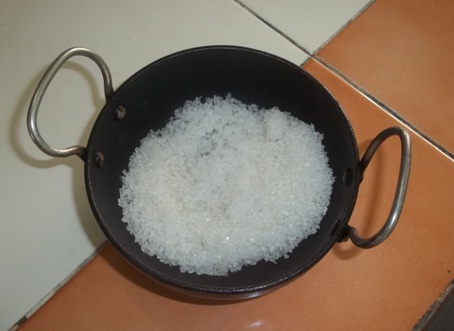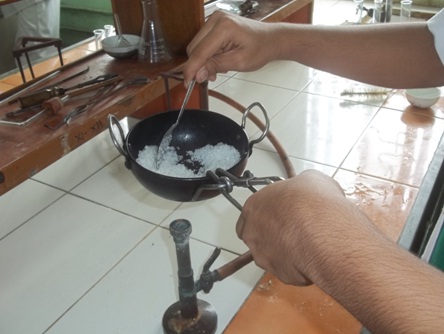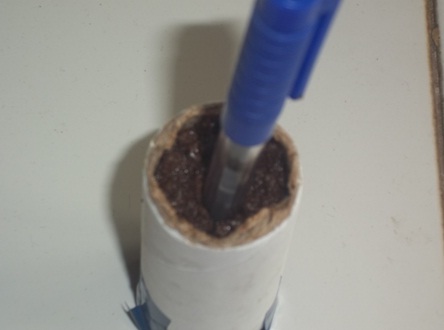





Published on Apr 02, 2024
To Prepare a Smoke Bomb.
A smoke bomb is a firework designed to produce smoke upon ignition. Smoke bombs are useful to military units, self-defense and pranks.The smoke bomb was first created in 1848, by the inventor Robert Yale. He developed 17th century Chinese-style fireworks and later modified the formula to produce more smoke for a longer period of time.
Coloured smoke devices use a formula that consists of an oxidizer (typically potassium chlorate, KClO3), a fuel (generally sugar), a moderant (such as sodium bicarbonate) to keep the reaction from getting too hot, and a powdered organic dye for colour. The burning of this mixture evaporates the dye and forces it out of the device, where it condenses in the atmosphere to form a "smoke" of finely dispersed particles.
Home-made smoke bombs are usually created in two ways:
The first way involves cutting up celluloid material (ping pong balls)-placing the small pieces inside an aluminium wrapping and igniting them. This practice is widely recognised to be a health hazard.
Mixing the chemicals potassium nitrate and sugar while lightly heating the mixture until it comes to a peanut-butter-like consistency can also provide fuel for smoke-bombs
• Sugar
• Potassium nitrate, KNO3, also known as saltpeter
• Skillet or pan
• aluminum foil or a used tissue paper roll
• Fuse for easy ignition(from fireworks)
• Cotton and tape
• Burner


1. Pour about 3 parts potassium nitrate to 2 parts sugar into the skillet (5:3 ratio is also good). Measurements don't need to be exact, but you want more KNO3 than sugar. For example, you can use 1-1/2 cups KNO3 and 1 cup sugar. If you use equal amounts of KNO3 and sugar, your smoke bomb will be harder to light and will burn more slowly. As you approach the 5:3 KNO3: sugar ratio, you get a smoke bomb that burns more quickly.
2. Apply low heat to the pan. Stir the mixture with a spoon using long strokes. If you see the grains of sugar starting to melt along the edges where you are stirring, remove the pan from the heat and reduce the temperature before continuing.
3. Basically you are caramelizing sugar. The mixture will melt and become a caramel or chocolate color. Continue heating/stirring until the ingredients are liquefied. Remove from heat.
4. Pour the liquid onto a piece of foil or into the cardboard roll. You can pour a smaller amount onto a separate piece, to test the batch. You can pour the smoke bomb into any shape, onto an object, or into a mold. The shape and size will affect the burning pattern.
5. If you aren't going to clean your skillet immediately, pour hot water into the pan to dissolve the sugar (or else it will be harder to clean). Clean up any residue you may have spilled out of the pan, unless you want mini-smoke bombs on your stovetop.
6. While the mix is still hot, push a pen lightly down the mold and don’t remove it. Allow the smoke bomb to cool.(about an hour) Now, remove the pen and insert the fuse.
7. Secure the fuse with cotton
Colored smoke bombs use a mixture of an oxidizer, a fuel, a moderant to keep the reaction from getting too hot, and a powdered organic dye. When the mixture is burned, the dye evaporates and is forced out of the device, where it condenses in the atmosphere to form a cloud of fine particles, the smoke.

Other smoke bomb compositions produce different products, but the principle is the same: a solid is produced and dispersed into the air, creating a smoke that scatters and blocks light.
The sugar will be oxidized to carbon dioxide and water. The nitrogen in the potassium nitrate will be reduced to nitrogen gas. The potassium will end up as potassium carbonate (the carbon coming from the CO2 from the sugar). Small amounts of other products will be formed, of course, but these are the only important ones.
48 KNO3 + 5 C12H22O11---> 24 K2CO3 + 24 N2 + 36 CO2 + 55 H2O
Smoke bombs are primarily used in military warfare as smoke screens:
Smoke screens are usually used by infantry to conceal their movement in areas of exposure to enemy fire and to conceal a withdrawal. They have regularly been used since earliest times to disorient or drive off attackers.For the crossing of the Dnieper river in October 1943, the Red Army laid a smoke screen 30 kilometres long. At the Anzio beachhead in 1944, US Chemical Corps troops maintained a 25 km "light haze" smokescreen around the harbour throughout daylight hours, for two months.
The density of this screen was adjusted to be sufficient to prevent observation by German forward observers in the surrounding hills.In the Vietnam War "Smoke Ships" were introduced as part of a new Air Mobile Concept to protect crew and man on the ground from small arms fire.
There are a number of examples of using incendiary weapons at sea, such as stinkpots, which also had the effect of creating smoke. It is not until Twentieth century that we get clear evidence of deliberate use of large scale naval smokescreens as a major tactic.During the American Civil War, the first smoke screen was used by the R.E. Lee, running the blockade and escaping the USS Iroquois (1859).
The use of smoke screens was common in the naval battles of World War I and World War II. Another application is in smoke grenades: Smoke grenades are canister-type grenades used as ground-to-ground or ground-to-air signaling devices, target or landing zone marking devices, or as screening devices for unit movements. Smoke grenades are normally considered non-lethal, although incorrect use may cause death.
The body consists of a sheet steel cylinder with a four emission holes on top and one on the bottom to allow smoke release when the grenade is ignited. The reaction is exothermic and grenade casings will often remain scalding hot for some time even after the grenade is no longer emitting smoke
http://wiki.answers.com
http://wikipedia.com
http://chemistry.about.com
http://wikihow.com